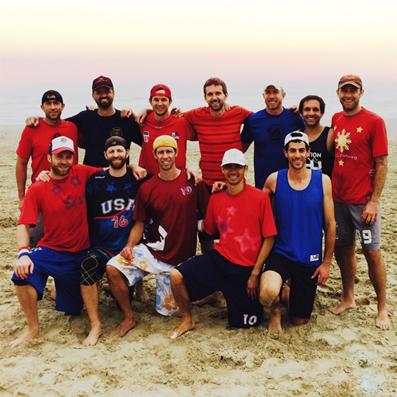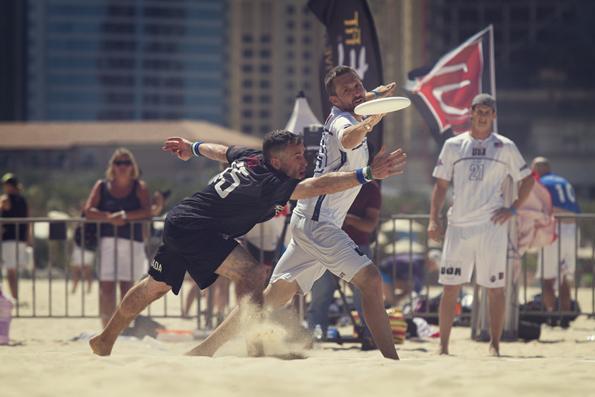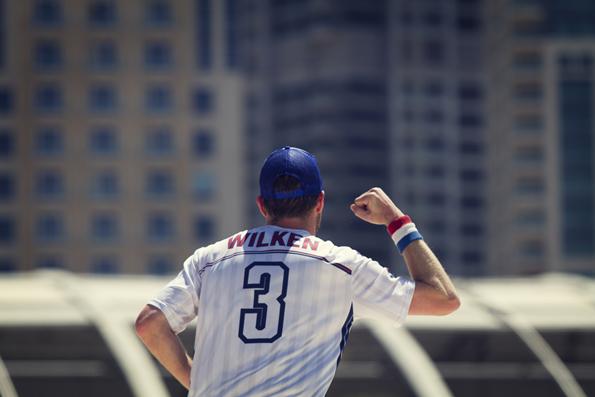Architecture of a Selfless Team: U.S.A. WCBU Men’s Masters
Sean McCall
Posted: April 9, 2015 11:27 AM
 |
In June 2014, I was entrusted to select the USA Ultimate National Team in the men's masters division (age 33+) for the World Championships of Beach Ultimate (WCBU) that would take place in March 2015 in Dubai, U.A.E., along with Ricky Eikstadt, a good friend and a respected opponent across the last 20 years. We were given a database of 200+ applicants who filled out a player bio questionnaire about their beach ultimate experience. We met in person in July to set the stage for the kind of team we wanted.
|
We were quick to agree on the architecture of the team. We wanted a team full of selfless players who would see the system and the team as larger than themselves and be perceived as appropriate delegates of USA Ultimate. We optimized for triple threats (handler + cutter + defender), geographic balance, big name vs. small(er)-market balance, height, age, beach experience and former captains, believing a player knows how to be a good teammate when they have been a leader themselves. We wanted to solve for the team vibe and "good citizen" players first and then determine if that group of players was strong enough to perform at the level we expected. It was. We released the selected players’ names to USA Ultimate for approval in August.

WCBU Masters U.S. National Team in Galveston, February 2015
We knew the process and preparation were just as important as the event or final result, especially in a short season that would straddle the November and December holidays. We knew we wanted to participate in several warm-up events to build relationships and trust to have our team feel connected to each other. We created a schedule that included a November warm-up event in Galveston, Lei Out in Los Angeles in January with the U.S. women's masters WCBU team and another warm-up event in Galveston in February. We established typical team communication channels like GroupMe, a Google doc and a workout log. Co-captain John Sandahl kept us focused during the cold winter months when it was easier to be thinking about something else.
The seeds of our success were sewn in our pre-WCBU execution. We had better than 75 percent of the team make each event. Absent guys and local guys subsidized team funds in lieu of their flight costs. We tapped relationships to put a team on the field on Sundays in Galveston to allow us to practice playing as a team. We had several setbacks: We lost Ricky when his wife's due date landed in March, we lost Chuck to a knee injury and we lost another to finances, but this team banded together and weathered the storms (and a leaky Galveston roof). Going into the tournament, we believed we might be the most connected and prepared team in any division from any country.

Photo: Get Horizontal
This set the stage for confidence going into WCBU in Dubai. Relying on the trust we built in our pre-season, we decided to experiment with not calling subs for the tourney, instead allowing players to insert themselves into the right spot at the right time to maximize their contribution. We reserved the right to call a line after a time out or a halftime, but we never felt like we needed to. We decided to optimize for the week, not just a game, and several players were selected to rest for one or more games. We focused our mental energy on games to three, instead of the overall score, resetting to 0-0 several times per game. We valued the player who created the "assist to the assist" to promote selfless play, focus on meaningful team performance and deemphasize the less meaningful individual stats of goals and assists. (Our best player was definitely not our stat leader. Sorry, Timmy.) We used a possession-based game chart to map our top opponents’ tendencies and top weapons.
The results tell the rest of the story. Across the 10 games of the tournament, we only lost two games to three, had our offensive team get broken only once and played a perfect game with zero team turns against Great Britain in pool play. We rarely knew the actual score, only the game-to-three score, and played lots of 2-2 points like it was double-game point. As the team hit their stride during the tournament week, we shortened our team meetings and abbreviated our warm-ups, by design. We performed consistently throughout the tournament, playing better as the week went on and scoring very well in team spirit scores in our division.

Photo: Get Horizontal
Several of the players on this team have commented that it was one of the most enjoyable teams they have ever played for. We think it is because of the investment of effort everyone made to operate selflessly inside a system larger than themselves. Perhaps this type of team architecture requires the maturity level of masters-age players. By their very architecture, most teams inadvertently prioritize on-field performance over alignment, culture and connectedness. But we believe you can have it all, especially when you invest in alignment, culture and connectedness at the beginning.
Since returning home, many friends, family, club teammates and coworkers have congratulated me on the gold medal. I appreciate their well wishes and congratulations, but the thorough realization of our team's vision and the attainment of our full potential is our true achievement.
Have any questions or comments? We welcome community feedback and discussion made in a respectful manner. Please refrain from profanity or personal attacks, as such public comments negatively reflect on our sport and community.